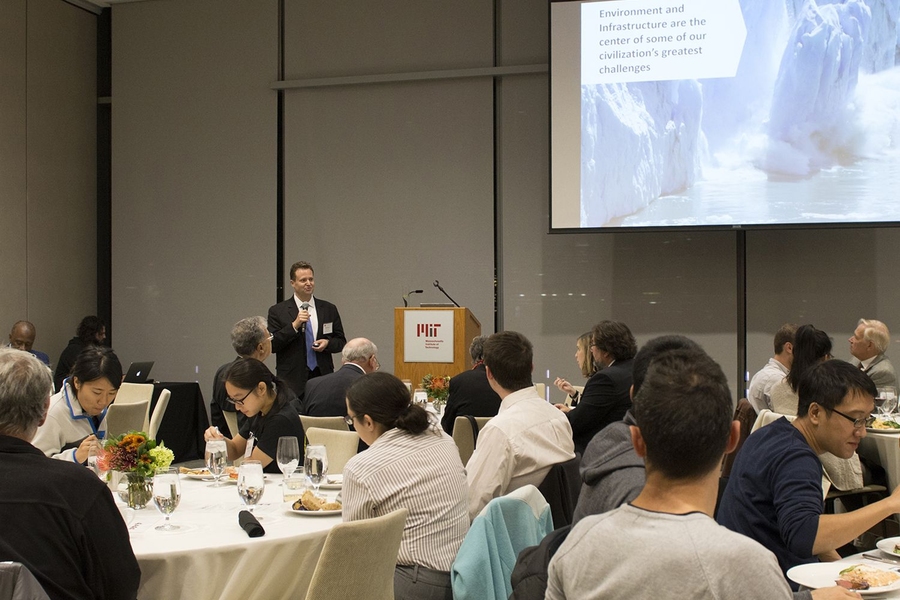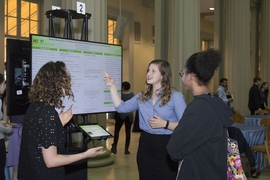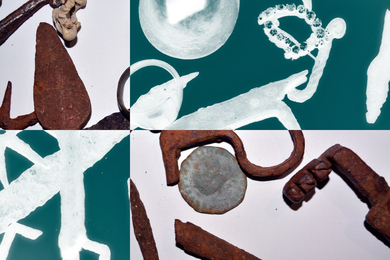On October 18, alumni, postdocs, graduate students, and professors gathered at the Department of Civil and Environmental Engineering’s annual New Research Alumni Reception. The annual event invites the broader MIT CEE community back to campus to network with peers and become informed about the innovative research projects that the civil and environmental engineering faculty are working on.
Topics covered ranged from machine learning and blockchain to regional impacts of global climate change, and creative computing for high performance design in structural design.
McAfee Professor of Engineering and department head Markus Buehler began the night by discussing new additions to CEE and MIT such as the grand opening of MIT.nano, the new MIT Schwarzman College of Computing to support the rise of artificial intelligence and data science, and a revamped student lounge named in honor of late professor and former department head Joseph Sussman.
Buehler also highlighted the fieldwork offered in CEE, such as ONE-MA3 (Materials in Art, Archeology and Architecture) in Italy; TREX (Traveling Research Environmental Experiences) in Hawaii; and the Agricultural Microbial Ecology subject led by Professor Otto Cordero during January Independent Activities Period in Israel. Furthermore, Buehler explained that CEE provides students with resources such as the new Internship program, alumni panels and receptions, and career fairs, which all offer students a competitive edge post-graduation.
“The future presents vast, global challenges. MIT is rising to meet them with a wide lens and broad scale work,” Buehler said.
Changing faces of computation
With MIT’s recent $1 billion investment going toward the new MIT Schwarzman College of Computing, Professor John Williams appropriately presented on “New Faces of Computation” — machine learning and blockchain — that are already impacting various aspects of our lives.
“We can now build machines that can learn to do things that we as humans can’t do,” Williams states. In other words, as noted previously by MIT President L. Rafael Reif, “in order to partner with these machines, we will all need to be bilingual.”
Williams also discussed the importance of MIT’s Geospatial Data Center (GDC), which focuses on computation research in data science, cloud computing, cybersecurity, augmented reality, the internet of things, blockchain, and educational technology. Williams and GDC research scientist Abel Sanchez, a CEE research scientist, are introducing a new two-month online course called Digital Transformation, which focuses on understanding the technologies driving radical changes in industry. The course provides an MIT certificate issued by the Professional Education Program, upon satisfactory completion.
The world has a vast amount of data that is constantly growing due to our devices, which are able to track everything and everyone. “The amount of data that we are generating has given rise to news innovations in machine learning,” Williams said. “We have big data that is now being leveraged by companies such as Facebook and Google.”
Williams explained that we are capable of creating smart cities by utilizing tools that can be applied to tracking people and transportation, producing detailed maps, conducting digital and high precision farming, and more. He added that the speed of our world is going to increase considerably because machines are capable of learning and outperforming humans.
Regional impacts of global climate change
While machine learning and big data are on the rise, so are the carbon dioxide emissions produced by human activity. Breene M. Kerr Professor Elfatih Eltahir discussed misconceptions of climate change, his research on the rise in global temperatures, and the relationship between climate and infectious diseases.
He explained that many people in America are aware that global warming exists, however, they do not believe it will directly influence their lives. Eltahir urged a shift in mindset, noting that we could experience very significant effects of global warming.
“What my group and I look at is how to translate the impacts of climate change into areas such as health, agriculture, water resources; focusing on what people care about at local and regional scales,” Eltahir explained.
Eltahir emphasized that alarming temperatures will be seen around the Persian Gulf, South Asia, and Eastern China, with some areas being uninhabitable during the summers. Eltahir and various CEE students collaborated in the creation of the MIT regional climate model (MRCM), as well as the Hydrology, Entomology and Malaria Transmission Simulator (HYDREMATS) in order to predict regional impacts of climate change.
Eltahir’s research also examines the relationship between climate and the spread of malaria, showing that there is a small window of temperature that mosquitoes can survive. Although climate change presents many challenges, it could also allow for a decrease in malaria transmission in parts of Africa.
Creative computing for high performance design in structural engineering
Integrating computation and climate with architecture, associate professor in CEE and architecture Caitlin Mueller explained how the utilization of machine learning and optimization tools early on in the design process can improve performance and merge structural engineering and design.
“I think performance, engineering, and efficiency can lead us to some of the most exciting design outcomes out there,” Mueller said.
Building off of Eltahir’s presentation, Mueller explained the impacts that construction has on the environment. According to Mueller, in the built environment, buildings use roughly 40 percent of energy worldwide and produce a similar proportion of global emissions. She stressed that the environment has not been part of the conversation enough in terms of design, but is hopeful that advancements in computation can help identify these impacts early on.
Mueller’s research lab, Digital Structures, focuses on linking architectural design and structural engineering through early tools or computational design, in order to help improve performance, energy efficiency, design, and cost.
In one example, Mueller developed a sofware called structureFIT, which helps designers create shapes for trusses and allows for human and computer collaboration. The software includes an interactive evolutionary algorithm where the computer suggests diverse and high-performing designs to the user.
With structureFIT and subsequent tools from Mueller’s group, the user is able to analyze the information about the performance of each design much more efficiently. Designers sort through various considerations such as how much material would be necessary, impact on the environment, and which designs are the most intriguing to them. However, the challenging part of this is that the computer generates an overwhelming amount of options.
Said Mueller: “There is huge opportunity to use advancements in data science and computation to start addressing this challenge we’ve created for ourselves.”
The machine clusters large data sets and organizes them into families of designs or typologies. Typology, a process that has always been manual, is now able to be sorted through the computer, providing the designer with instantaneous feedback. Another example of a machine learning application includes surrogate modelling, which uses real-time approximations for slow simulations to give designers real-time performance information in design processes.
With the help of robots that 3-D print extremely efficient and complex structures, Mueller is able to materialize these designs, while maintaining creativity and performance.
“Using this combination of state-of-the-art path planning algorithms with topology optimization, we can finally make these structures a reality,” Mueller said.
“We are investigating a lot of different topics, and collaborating with students in computer science,” she said. “What really unites us is that performance can absolutely play a critical role in creative design when we use these digital tools in creative ways.”
The alumni and community members present expressed enthusiasm about the new research projects coming from the department — from computation, to climate change and architecture, the innovative research was described as interrelated and highly impactful. After questions and discussion from the attendees, the evening concluded.
“The research our faculty conduct on a daily basis is inspiring,” said Buehler, reflecting on the night. “It is always gratifying when we have the opportunity to show alumni the innovative direction the department is moving in.”











